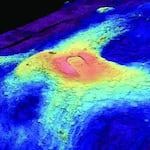The most active volcano in the Pacific Northwest is the Axial Seamount. It’s located 300 miles west of Astoria, Oregon, and a mile under the ocean. It’s erupted three times in the past 25 years.
And now after a few years of relative slumber, the undersea volcano appears to be waking up again. Data collected on Axial show the magma chamber is filling up and hundreds of small earthquakes are happening in the area each day.
“Axial is the most active volcano in the Northeast Pacific, which maybe some people don’t know because it’s hidden under the ocean,” said Oregon State University volcanologist Bill Chadwick. “It’s actually more active than any of the volcanoes we’re familiar with, like the ones in the Cascades — Mount St. Helens, Mount Hood, Mount Rainier.”
Related: Deep-sea volcano off the Oregon Coast helps scientists forecast eruptions
Chadwick and his colleagues have been studying the Axial Seamount for decades, traveling to the volcano every couple of years to collect data from instruments on the seafloor.
The Axial Seamount is a shield volcano — like you’d find in Hawaii or Iceland — meaning it doesn’t blow its top when it erupts. Instead the magma below causes it to crack open on its slopes and ooze syrupy lava.
“It doesn’t have that flashy, ‘Axial’s gonna erupt and cause a tsunami,’” said Jeff Beeson, a geologist at Oregon State University. “It’s not happening. [The volcano is] not going to erupt and have a lava flow that goes into someone’s backyard.”
But because Axial is so active, it’s extremely valuable for scientists who are trying to learn about volcanoes.

In this video still, Oregon State University volcanologist and chief scientist on the research cruise, Bill Chadwick (right), works on schedule for the multiple projects happening aboard the RV Thompson.
Stephani Gordon/OPB / OPB
“We’re trying to understand how it evolves over time. How the magma moves leading up to an eruption and during an eruption. What happens right after an eruption? These are things that are not really that well understood about volcanoes in general,” said Chadwick’s research partner Scott Nooner, a geophysicist at the University of North Carolina, Wilmington.
They’re also trying to figure out how to accurately forecast when volcanoes will erupt, work that is funded in part by the National Science Foundation.
The last time the Axial Seamount erupted was in 2015. Almost immediately after the eruption, scientific instruments around the volcano showed that the surface was rising up, inflating like a balloon, an indication that the magma chamber had started to rapidly fill up again. And so it looked as if the volcano was heading towards another eruption.
Related: Battling crabs 250 miles off the Oregon Coast, while studying an underwater volcano
Seeing this rapid inflation, Chadwick predicted that the volcano would erupt between 2020 and 2024. But almost immediately after he published that prediction, Axial seemed to change its mind. Chadwick says the rate of magma buildup “slowed way down.” And Axial has not erupted again.
“It’s always going to be somewhat of a challenge to really know what’s happening underground where you can’t see it,” Chadwick said.
But this past January, things started to change again. Data collected by the Ocean Observatories Initiative Cabled Array (a permanent cable running from Pacific City, Oregon, out to the Axial Seamount) indicates the rate of seafloor inflation has nearly doubled.

Visualization of the Axial Seamount, an active volcano off the Oregon Coast.
NOAA
In addition, researchers at the University of Washington have observed the number of small earthquakes happening around Axial has increased significantly. Before the eruption in 2015, researchers saw the number of earthquakes skyrocket.
“Comparing this to the buildup to the 2015 eruption … suggests we may be getting close to being in a comparable buildup stage,” Chadwick wrote in his blog.
Based on what he’s seeing, Chadwick says he has a new and “wildly optimistic” Axial eruption forecast: sometime in 2025 or 2026.
“At a real dangerous volcano, you don’t want to be issuing any predictions that you’re not sure are going to be true, because people might have to evacuate. There could be economic costs and freaking people out,” he says.
Related: Scientist Hot Take: Pacific Northwest Volcano Forecast To Erupt Within 4 Years
But at the natural laboratory that is the Axial Seamount, Chadwick has the latitude to experiment.
“Here, there’s just a bunch of tube worms and octopus on the seafloor. They don’t care.” he laughs. “They don’t read the newspaper.”
At Axial, he can try to figure out ways to accurately forecast volcanic eruptions that could eventually be used to make life-saving predictions when it counts.
Note: This story was updated on July 8, 2024 to add the National Science Foundation as a financial supporter of this research.

In this still from video provided by Woods Hole Oceanographic Institution, a remote operated vehicle called Jason encounters a deep-sea octopus living on top of the Axial Seamount.
Courtesy of Woods Hole Oceanographic Institution
